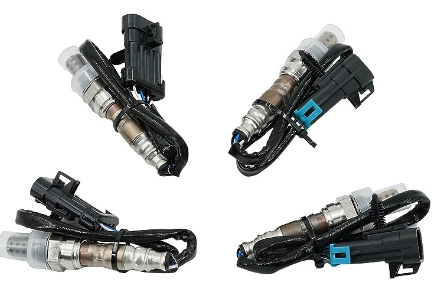Your cart is currently empty!
What are the oxygen sensor common faults ? What can be seen by observing the color of the tip of the oxygen sensor?
Today's vehicles are equipped with two oxygen sensors, one in front of the three-way catalytic converter and one in the rear. The function of the front is to detect the air-fuel ratio of the engine under different working conditions, and the computer adjusts the fuel injection amount and calculates the ignition time according to the signal. The rear is mainly to detect whether the three-way catalytic converter is working well or not! That is, the conversion rate of the catalyst. An important basis for detecting whether the three-way catalytic converter is working normally (good or bad) by comparing with the data of the front oxygen sensor. Let's learn about the common faults of the oxygen sensor? What can be seen by observing the color of the top part of the oxygen sensor.

What are the common faults of oxygen sensors
1. Oxygen sensor poisoning
Oxygen sensor poisoning is a kind of failure that often occurs and is difficult to prevent, especially for cars that often use leaded gasoline. Even a new oxygen sensor can only work for a few thousand kilometers. If it's just mild lead poisoning, then using a tank of unleaded gasoline will remove the lead from the surface of the oxygen sensor and restore it to normal operation. But often due to the high exhaust temperature, lead invades into its interior, hinders the diffusion of oxygen ions, and makes the oxygen sensor invalid. At this time, it can only be replaced.
In addition, silicon poisoning of the oxygen sensor is also common. Generally speaking, the silicon dioxide produced by the combustion of silicon compounds contained in gasoline and lubricating oil, and the organosilicon gas emitted by improper use of silicone rubber sealing gaskets will cause the oxygen sensor to fail, so good quality fuel and lubricating oil should be used . When repairing, the rubber gasket should be selected and installed correctly, and the sensor should not be coated with solvents and anti-sticking agents other than those specified by the manufacturer.
2. Carbon deposition
Due to poor combustion of the engine, carbon deposits are formed on the surface of the oxygen sensor, or deposits such as oil or dust enter the interior of the oxygen sensor, which will hinder or block the outside air from entering the interior of the oxygen sensor, making the signal output by the oxygen sensor inaccurate, and the ECU cannot timely correct the air-fuel ratio. The generation of carbon deposits is mainly manifested in the increase of fuel consumption and the obvious increase of emission concentration. At this time, if the deposit is removed, normal operation will resume.
3. Oxygen sensor ceramic fragmentation
The ceramic of the oxygen sensor is hard and brittle, and it may break and become invalid if it is struck with a hard object or blown with a strong air flow. Therefore, special care must be taken when handling, and replacements shall be made in time if problems are found.
4. The resistance wire of the heater is blown
For the heating type oxygen sensor, if the heater resistance wire is ablated, it is difficult to make the sensor reach the normal working temperature and lose its function.
5. The internal circuit of the oxygen sensor is disconnected.
6. Inspection of the appearance color of the oxygen sensor
Remove the oxygen sensor from the exhaust pipe, check whether the vent hole on the sensor housing is blocked, and whether the ceramic core is damaged. If damaged, the oxygen sensor should be replaced.
Observe the color of the top part of the oxygen sensor to judge the fault
Light gray tip: this is the normal color of the oxygen sensor;
White top: caused by silicon contamination, the oxygen sensor must be replaced at this time;
Brown tip: caused by lead pollution, if severe, the oxygen sensor must also be replaced;
Black top: It is caused by carbon deposits. After the engine carbon deposits are eliminated, the carbon deposits on the oxygen sensor can generally be automatically removed.
The main oxygen sensor includes a heating rod that heats the zirconia element. The heating rod is controlled by the (ECU) computer. When the air intake is small (the exhaust temperature is low), the current flows to the heating rod to heat the sensor, so that the oxygen concentration can be accurately detected.
Platinum electrodes are set on the inner and outer sides of the test tube state zirconium element (ZRO2). In order to protect the platinum electrodes, the outer side of the motor is covered with ceramics. The inner input oxygen concentration is higher than the atmosphere, and the outer input oxygen concentration is lower than the exhaust gas concentration of the car.
It should be pointed out that after using the three-way catalytic converter, unleaded gasoline must be used, otherwise the three-way catalytic converter and oxygen sensor will fail quickly. Note again that the oxygen sensor plays an important role in stabilizing the throttle and preparing a standard mixture, but when the mixture is frequently enriched or thinned, the (ECU) computer will ignore the information of the oxygen sensor, and the oxygen sensor will not work.






Leave a Reply